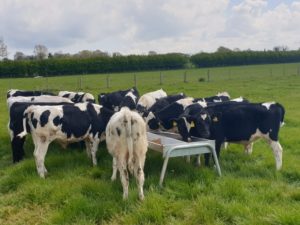CAFRE Introduces New Dairy Calf to Beef Knowledge Transfer Project
May 20, 2020
Natasha Ferguson, CAFRE Beef Technologist
Recent data produced by the Livestock Meat Commission showed that 41% of the 2019 prime cattle produced in Northern Ireland originated from the dairy herd. It is anticipated that this figure will continue to increase within the beef sector across Northern Ireland year on year. CAFRE have established that there is potential to demonstrate profitable dairy calf to beef systems. This new Knowledge Transfer project is based on research conducted by Teagasc.
A well-managed dairy beef steer system has the potential to sustainably produce consistently high quality beef in addition to positive margins at farm level whilst meeting market requirements. The average age at slaughter of dairy origin steers across Northern Ireland in 2019 was over 26 months. CAFRE are aiming to reduce the age at slaughter of our dairy bred steers from an average of 24 months to 20 months. The main driver of this change in the system is to maximum utilisation at grass, maintain the stocking rate across the farm and to potentially reduce the carbon footprint. This system reflects favourably on animal welfare as the animals have access to pasture over an extended grazing season.

CAFRE Dairy Beef calves out at grass May 2020.
The dairy bred calves originating from the CAFRE dairy herd are reared in the new CAFRE calf rearing facilities on automatic feeders. These dairy beef calves are weaned at 10 weeks of age and are transferred to the weaning shed until turnout. Currently 40 Holstein and dairy beef cross steer calves have been retained for this CAFRE KT Project entitled ‘Management of dairy bred beef calves to maximise lifetime performance’. A number of key management areas have been identified for demonstrating within this project and are as follows:
1) Colostrum quality, feeding and management;
2) Determining successful passive transfer of colostrum;
3) Animal nutrition;
4) Animal health;
5) Grassland management;
6) Growth performance.
A key element to a profitable dairy calf to beef system is the efficient utilisation of grazed grass. Grazed grass is the cheapest source of energy for ruminants and is capable of supporting high levels of animal performance. The aim this current grazing season is to implement a rotational grazing strategy to maximise calf performance at grass. Using grass measurement software we aim for pre-grazing cover targets of 3000kgDM/ha grazed to approx. 1600kgDM/ha. Calves will also receive a daily allocation of 1kg concentrate at grass and performance monitored regularly in conjunction with routine procedures. This concentrate level can be increased if grass availability becomes an issue with the current weather conditions. The 15 autumn born Holstein steers were turned out to grass on the 4th May 2020. Average turnout weight was 239kg averaging 6 months of age (achieving 1.2kg daily live weight gain from birth). At present the calves are slightly above the target weight of 220kg at 6 months of age which will be beneficial for housing in the autumn. To maximise grass production and utilisation soil fertility, drainage, sward composition and paddock infrastructure need to be optimised on the farm. Target weights for the dairy calf to beef project are highlighted in Table 1 below:
Table 1: Target growth rates for dairy born calves at CAFRE beef and sheep centre
| Age | Target Liveweight (kg) | DLWG (kg/d) |
| 6 Months | 220 | 0.9 |
| 14 Months | 450-470 | 1.0 |
| 18-20 Months | 600-680 | 1.2 |
Over the next two – three years we will be providing regular updates on this project in the form of press updates and Knowledge Transfer awareness events.
For further details in relation to this KT project please email: Natasha.Ferguson@daera-ni.gov.uk
